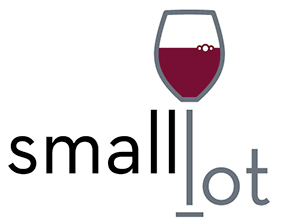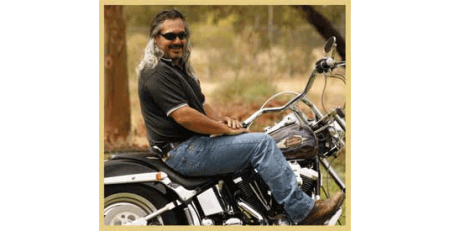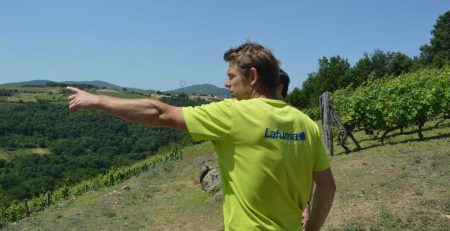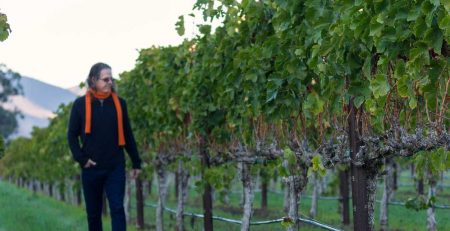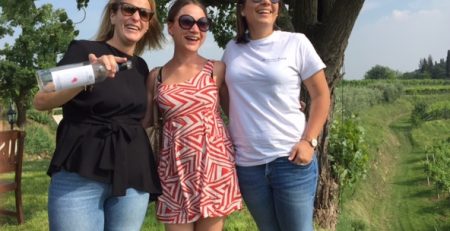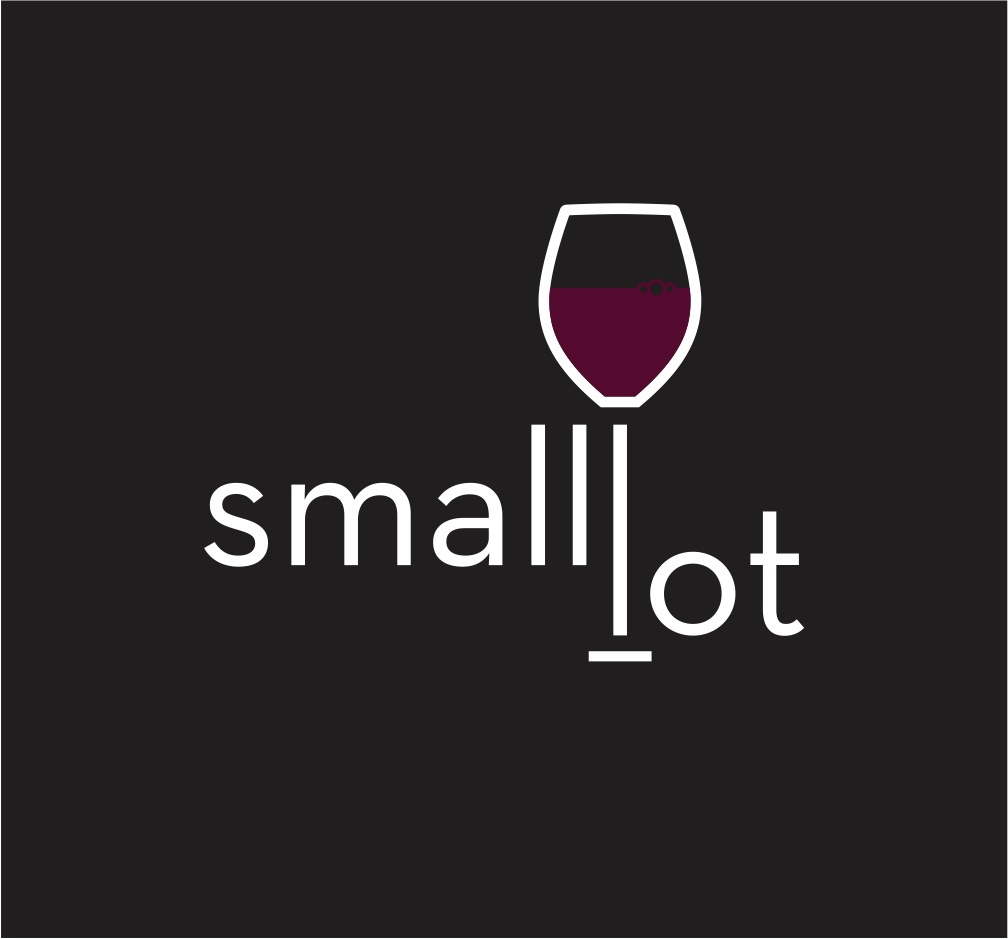Red Willow Vineyard: The Epitome of People and Place

I woke up Friday morning, August 12th, and just had the feeling that it was going to be a great day. The weather forecast said “beautiful” and we had a nice schedule of wine learning opportunities planned – vineyard work, grape tasting, wine tasting and food (lots of food). With such a perfect day planned, I should not have been surprised to get a phone call shortly after 8 am that would essentially derail the first half of the day.
Lady Hill Winery proprietor, Jerry Owen, was able to clear his schedule and was driving from Portland up to Yakima with his new winemaker, Dan Duryee, to visit Red Willow Vineyard and check fruit before harvest. We were invited to join them and were told to give him a call when we were done clipping vines at Two Mountain Winery in Zillah (around 10 am) so he could give us directions. Directions? But we have GPS. No, we would need directions, this place was a tad off the grid.
So after Vine Pruning 101, courtesy of Two Mountain vineyard manager, Patrick Rawn, and a refreshing 10 am Sauvignon Blanc to prime the pump, I called Jerry to figure out where we were headed. “Take the Toppenish exit off of 82, and head west on Wapato Road,” he said. “Keep going for about 25 minutes until the road T’s. Take a right and head up the hill a couple miles. It’s a historic vineyard, you guys are going to love it!”
Executing these directions sounded simple, but 16 miles out into the Yakima Nation Reservation heading straight toward the west end of the valley and the foothills of the Cascades, we had some serious doubts. The scenery was very reminiscent of my family’s farm in eastern Montana – big, barren, August-brown hills, sagebrush, wheat fields… and then, vines.

The farmyard at Red Willow Vineyard looks like any other – outbuildings, equipment and people milling around – but the iconic Chapel atop the hill and vines with trunks bigger than my quads meant that this place was different. This place was special.
We found Jerry, Dan and, vineyard owner/farmer, Mike Sauer, in one of the shed buildings. The room was cool and large, with folding tables and chairs set for 12. A nice place to get out of the heat which was already well above 90 degrees. The walls were adorned with photographs of the vineyard and its people – the chapel in the snow, generations of the Sauer family, local priests come to bless the harvest – most all of them, we would learn, was taken by Mike himself.
I have known Jerry Owen for a couple years now and count him as one of my absolute favorite suppliers to see accounts with. On the surface, Jerry looks like the type of guy that would take you fly fishing or mountain biking and talk outdoors, but upon very first meeting it is completely evident that he is a very multi-faceted man. Jerry has a Master’s in English Literature and is a consummate family man, gentleman, and scholar with the unique ability to take the most mundane conversation and bring it to a deeper level in seconds. He does not have a superficial bone in his body. Everything he does has intent and purpose. Jerry and Mike are cut from the same cloth.
To meet Mike Sauer in the context of our mutual friend and colleague almost certainly augmented the experience for me. Mike would appear to be like any other Yakima Valley farmer, his skin weathered and tan from years in the dry heat, working the soil and tending vines – the type of guy who might have lived his whole life within 50 miles of his family farm. But like his friend, Mike is a man of deep intellect, artistic passion, and great faith – a true steward of the land. He is also extremely well-traveled and has a truly refined palate; which of course lends itself well to growing some of the best wine grapes in the Northwest.

After some getting-to-know-you chat, we set out in the midday heat for a vineyard tour. Mike and Dan drove a two-seater, while Jerry joined my foursome on the 5-seat Mule ATV. Driving along the vineyard blocks, each is labeled for the varietal. Rows are numbered as well as tagged for the producer who has contracted those grapes. This list is a veritable Who’s Who of Washington’s top producers: DeLille, Mark Ryan, and Owen Roe to name a few. Some producers had whole blocks designated, while others may be only a row or two. Looking at these stately, well-trained vines with their maturing clusters it was immediately apparent – these vines were old and their fruit was probably quite expensive. We tasted Cabernet Franc from the oldest plantings in the state and two clones of Sangiovese which go into Lady Hill’s Procedo Red, before making our way up the dusty hill to some very old blocks of Syrah which surround The Chapel at Red Willow Vineyard. These vines are original cuttings from Joseph Phelps vines in Stag’s Leap District of Napa Valley, and it is speculated that Phelps got his cuttings straight from E. Guigal’s vineyards in the Northern Rhone.
 As one can see from the innumerable pictures of it, The Chapel is not a grand or ornate structure – maybe 10 feet by 14 feet by 14 feet high – but is one of quiet, magnificent reverence (a direct reflection of its owner). It came into being after Mike and his wife had returned from a trip to Europe where they had admired the ancient, hilltop chapels which overlook the vineyards there. Most famously, La Chappelle in Hermitage, which produces Paul Jaboulet’s most sought-after offering.
As one can see from the innumerable pictures of it, The Chapel is not a grand or ornate structure – maybe 10 feet by 14 feet by 14 feet high – but is one of quiet, magnificent reverence (a direct reflection of its owner). It came into being after Mike and his wife had returned from a trip to Europe where they had admired the ancient, hilltop chapels which overlook the vineyards there. Most famously, La Chappelle in Hermitage, which produces Paul Jaboulet’s most sought-after offering.
It was then that Mrs. Sauer turned to her husband and said, “I supposed we should have a chapel on our hill, too.” He agreed although I think he may have had his heart set on it already. Upon their return, Mike contacted a Mexican stone mason and artist who had previously done some retaining wall work for them and ran the idea past him. The idea was met with full enthusiasm and respectful vision for the project. It was built using stones from throughout the area, some native from the hills and some brought to the valley floor from Montana by the Missoula Floods some 15,000 years ago. It took 3 years to complete the small building, doing everything by hand.
Entering The Chapel through its heavy iron gate was something surreal. The room is empty except for its singular stone pew and kneeler adorned with 2 candles and the simple crucifix on the front wall. Yet in this small, simple, handmade room there is great power and peace. The peace in this room is palpable. You feel it, you breathe it in, you share it with those who are with you. If only for a few minutes, time slipped away. Then, back into the bright sun and glaring heat.
We follow Mike and Dan down the hill on the ATVs and just north onto another vineyard trail where we head west again. Past some brand new vine plantings and a block of Concord grapes (that actually smell like Welch’s grape jelly!) we come to a block of Barbera – again, the oldest planting in the state. Lady Hill has a tag on these grapes too and I know the end product – Lady Hill’s tiny production Procedo Barbera – and it’s pretty much magic. By his own admission, Mike Sauer isn’t a huge fan of Barbera (or Zinfandel either) but loves his Syrahs and Cabernets. The grapes are super-juicy, ringing with acidity and the lush, purple fruit flavors are nearly developed. With 100+ degrees in the forecast for the next two days, the sugar levels could spike and these grapes might need to get picked. We examine the vines and leaves closely and hope that the foliage is enough to shade these great clusters…and that the weatherman is off by maybe 5 degrees.



Dusty and sunburnt we saddle up for one last ride back to the cool respite of the conference room where we unfurl our pre-packed picnic lunch. Now the fun can start. We open up a barrel-fermented Sauvignon Blanc that is fruit from Red Willow as well as the equally well-known Boushey family. Delicious and refreshing. By now we have noticed a pattern – Washington producers don’t take Sauv Blanc too seriously, but do use it often as a thirst quencher…when in Rome. And with the meal a Lady Hill Fons Amoris Cabernet Sauvignon 2012 and an 8 Bells Syrah 2013 (with 4% Viognier, 2% Grenache co-fermented) – both 100% Red Willow Vineyard.
The Syrah is a textbook example of new world fruit and old world style. Dark red fruit, leather, and spice, wrapped in a silky, yet powerful finish. I must acknowledge that we tasted two other 2013 Red Willow Vineyard Syrahs on the trip, and this was far and away a superior wine. The Cabernet was stunning wine as well with deeply concentrated cassis and tobacco flavors and a plush finish, all typical of the near-perfect 2012 vintage. To argue which of these is better is merely a matter of personal preference. Both are exquisite examples of what Red Willow fruit can do in the hands of a great winemaker who cares about maintaining the wines unique sense of place.
